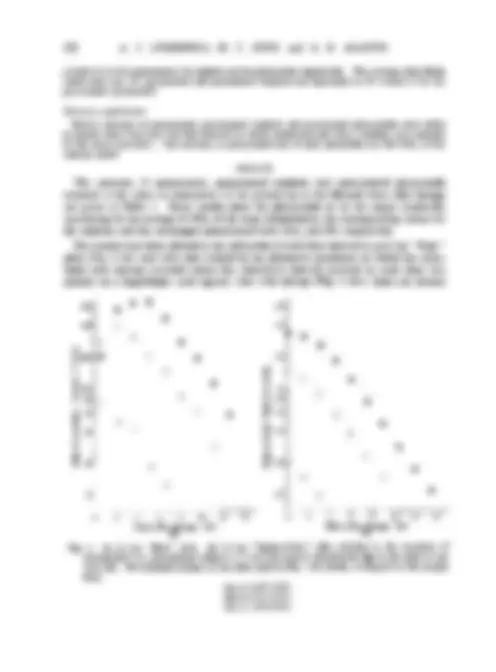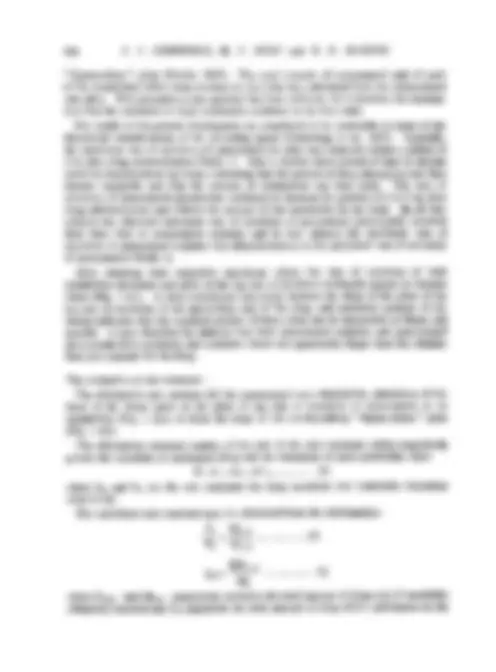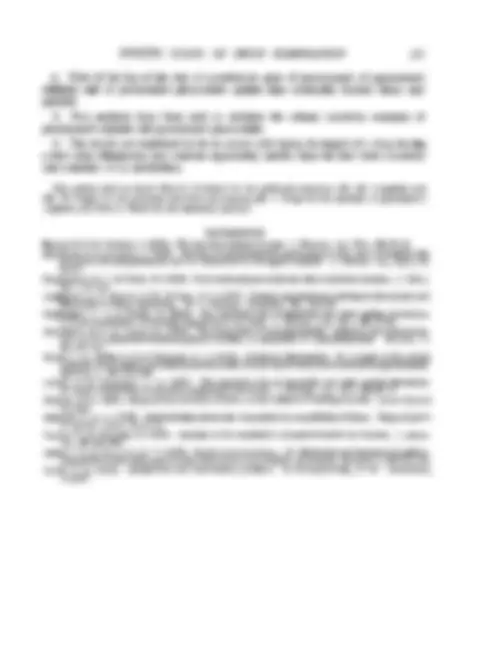






Study with the several resources on Docsity

Earn points by helping other students or get them with a premium plan


Prepare for your exams
Study with the several resources on Docsity

Earn points to download
Earn points by helping other students or get them with a premium plan
Community
Ask the community for help and clear up your study doubts
Discover the best universities in your country according to Docsity users
Free resources
Download our free guides on studying techniques, anxiety management strategies, and thesis advice from Docsity tutors
A study on the excretion of paracetamol and its metabolites, paracetamol sulphate and paracetamol glucuronide, in urine after dosage. The study involved the separation and determination of these compounds using thin-layer chromatography and the calculation of their excretion rate constants. The document also discusses the theoretical considerations and methods used in evaluating the excretion rate constants.
Typology: Study notes
1 / 8

This page cannot be seen from the preview
Don't miss anything!





Br. J. Phannac. Chemother. (1967), 29, 150-157.
From the Nicholas Research Institute, Slough, Bucks.
(Received May 25, 1966)
of rabbits dosed with paracetamol or with a drug which gives rise to paracetamol (Smith
paracetamol, calculated from the results of such studies, has^ been^ reported to^ be^ within the range 1.6 to 2.8 hr (Nelson & Morioka, 1963).
paracetamol, and of its glucuronide and sulphate in^ urine.
METHODS Chemical methods The following compounds were used as standards in the analytical procedures: (i) Paracetamol B.P. (ii) Paracetamol sulphate, potassium (^) salt monohydrate. Potassium p-nitrophenylsulphate was prepared by (^) the method of Burkhardt & Wood (1929) and reduced to the p-aminophenylsulphate by hydrogenation in aqueous solution using 5% palladium on charcoal at room temperature and atmospheric pressure. This was acetylated with acetic anhydride and recrystallized from aqueous ethanol to give p-acetamidophenylsulphate, which was isolated as the potassium salt. Analysis of the product gave: C, 33.0; H, 3.51; N, 4.91; H20, 6.27%. CH3CO, 15.0%. (Calc. for CsHsNOS, K, H20: C, 33.4; H, 3.51; N, 4.88; H20, 6.35%. CH3CO, 15.3%). (iii) Paracetamol (^) glucuronide, potassium salt, was isolated by the method of Kamil, Smith & Williams (1952) from the urine of rabbits which had been dosed with paracetamol. The product was dissolved in ethanol, 2 N-potassium hydroxide in methanol was added until the solution was slightly alkaline (pH 8). The precipitate was dissolved in a small volume of methanol, 0.5 vol. of ethanol was added and the precipitate collected. The product which was a white powder was dried and stored (^) in a desiccator. Analysis gave: C, 45.6; H, 5.3; N, 3.8%. (Calc. for C14H17NOs, K: C, (^) 45.9; H, 4.7; N, 3.8%).
Separation of the standard compounds The separation of paracetamol, paracetamol sulphate and paracetamol glucuronide standards was effected by thin-layer chromatography on silica gel using the solvent system, ethyl acetate, methanol, water, acetic acid (60:30:9: 1, v/v). With an ascending development, the RF values of these compounds approximated to 0.82, 0.63 and 0.25 respectively.
The determination of paracetamol and of two of its metabolites in urine after dosage with paracetamol Total urine collections were made at 1.5 hr intervals for 15 hr after the administration of para- cetamol (12 mg/kg body-weight) to four men. Urine was also collected over four 1.5 hr periods on the day before the study, for the determination of an average "^ blank "^ value for the drug and the metabolites for (^) each man.
Thin-layer chromatography of the urine collected after dosage with paracetamol revealed three substances with RF values respectively corresponding to those of paracetamol, paracetamol sulphate and paracetamol glucuronide. Further evidence for the identity of the substances isolated from the chromatograms, was obtained by comparison of their respective infra-red absorption spectra with those of the standard compounds. Paracetamol, paracetamol sulphate and paracetamol glucuronide (^) were determined in the 1.5 hr urine samples as follows. The urine (0.75% (^) of volume) was applied to form a narrow 18 cm band near the bottom of a 20 x 20 cm thin-layer (^) chromatography plate spread with a 0.3 mm layer of silica-gel (Merck, GF 254). The chromatograms were developed with the (^) solvent described above until the front had travelled 12 cm, then paracetamol and the two metabolites (^) were revealed as dark bands against a fluorescent background by examination under ultraviolet light. (^) Horizontal lines were drawn across the plates to isolate three strips of silica gel each (^) containing one (^) of these compounds and for any one compound the width of the strip was kept constant; this procedure ensured (^) a constant blank value. The whole of the silica gel within this strip was scraped off and quantitatively transferred into S ml. of water. Then, after shaking for (^30) min the silica gel was removed by centrifuging and the extinction of the supernatant solution was measured at 240 mP against a reagent blank. All three compounds exhibited maximum absorption at this (^) wavelength. Standard solutions of (^) paracetamol, paracetamol sulphate and paracetamol glucuronide were treated in the same way as the urines. (^) Plots of extinction against concentration for the three compounds were linear over the required range. The (^) reagent blank depended upon the amount of silica gel removed from the chromatogram, the (^) average values were equivalent to 22, 46 and 121
KINETIC STUDY OF DRUG (^) ELIMINATION
I i
I I7^ 'IO^ C1N
%0%
mr
Ien
en^ n^ r_.
1.40 Int
0n00 -4i C -~~~~~~~~-
en4u
000 0%~~~C
tn ~ ~ ~ ~ _
('C4 --
4~^00 _ 4.000^, N
0 *^ - U
153
ON 00
I0I No
0
x
00
'I. en
0 0
._
00
o
N.a
cis
o
0
0
_- l
F-
(^0) Q
00
o_
ON
w_^ 0~
N
t (^) eno %D
I I
No _
00 , (^) 00o
(^00) 00,%o
_ o%^ o~
0%0 o
,
0oo N 'fo 0%w('4- 0S 0 o (^000) X
O 0
I
Q - eWm
I..) (^) n (^) '- ire u -~ '.0 0
'-
0%0 0
c.4 N~ N-
00
_4 '"
Pk Pk^ on^ Pko
" Sigma-minus " plots (Martin, 1967). The total amount of paracetamol and of each of the metabolites which were excreted in the urine was calculated from the extrapolated
tion that the excretion of these substances continues to be first order. The results of the present investigation are considered to be explicable in^ terms^ of the
parallel. It may therefore be deduced that both^ paracetamol sulphate and^ paracetamol
The individual rate constants may be^ calculated^ from^ the^ relationships: kF (^) MU (^) .(2) kD (^) Duso
kD= ................K.^ (3) DAL where (^) DIOO and (^) Muw respectively represent the total^ amount^ of^ drug^ and^ of^ metabolite ultimately excreted and D represents the total^ amount^ of^ drug which^ participates^ in the
results in this instance. DISCUSSION
parallel to the plot for paracetamol and the elimination (^) rate constant for paracetamol
of K and the (^) value of ku of paracetamol glucuronide. When theoretical (^) log "Rate"
cetamol metabolites" in (^) urine.
SUMMARY
The authors wish to thank Miss B.^ Croxford^ for her technical^ assistance,^ Mr. M. Longsdale and Mr. M.^ Rogers for the^ elemental^ and^ infra-red^ analyses, Mr. J.^ Verge for^ the^ synthesis of paracetamol sulphate and Miss A. Wylie for the statistical analyses.
REFERENCES BRODiE, B. B. & AXELROD, J. (1948). The fate of acetanilide in man. J. Pharmac. exp. Ther., 94,29-38. BRODiE, B. B. & AxELROD, J. (1949). The fate of^ acetophenetidin (phenacetin) in man, and methods for the estimation of^ acetophenetidin and its metabolites in^ biological^ material.^ J.^ Pharmac.^ exp. Ther., 97, 58-67. BURKHARDT, G. N. & WooD, H. (1929). Nitro-arylsulphuric acids and their reduction products. J. Chem. Soc., 141-152. CuMMINGS, A. J., MARTIN, B.^ K.^ & PARK, G. S.^ (1967). Kinetic^ considerations^ relating to^ the^ accrual^ and elimination of^ drug metabolites.^ Br. J.^ Pharmac.^ Chemother. 29, 136-149. GREENBERG, L. A. & LESTER, D. (1946). The metabolic fate of acetanilid and other aniline derivatives. I. (^) Major metabolites of acetanilid appearing in the urine. J. Pharmac. exp. Ther., 88, 87-98. JAGENBURG, 0. R. & TOCZKO, K.^ (1964). The^ metabolism of^ acetophenetidine. Isolation^ and^ characteriza- tion of (^) S-(l-acetamido-4-hydroxyphenyl)-cysteine, a metabolite of acetophenetidine. Biochem. J., 92, 639-643. KAMIL, I. A., SM1TH, J. N. & WILLIAMS, R. T. (1952). Studies in detoxication. 41. A study of the optical rotations of the amides and triacetyl methyl esters of some biosynthetic substituted phenylglucuronides. Biochem. J., 50, 235-240. LESTER, D. & GREENBERG, L.^ A.^ (1947).^ The metabolic^ fate^ of^ acetanilid^ and^ other^ aniline^ derivatives. II. Major metabolites^ of acetanilid^ appearing in the^ blood.^ J.^ Pharmac.^ exp. Ther., 90, 68-75. MARIN, B. K. (1967). Drug urinary excretion studies-a new method of^ treating the data. Nature (Lond.) In press. M6RNER, K. A. H. (1889). Stoffwechselproducte des^ Acetanilids^ im^ menschlichen^ Korper. Hoppe-Seyler's Z. physiol. Chem, 13, 12-25. NELsoN, E. & MORIoKA, T. (1963). Kinetics of the metabolism of acetaminophen by humans. J. pharm. Sci., 52, 864-868. SM1TH, J. N. & WILLIAMS, R. T.^ (1949). Studies^ in^ detoxication.^ 22.^ Metabolism^ of^ phenacetin (p-ethoxy- acetanilide) in the^ rabbit^ and^ a^ further observation^ on^ acetanilide^ metabolism.^ Biochem.^ J., 44,239-242. SMITH, P. K. (1958). Metabolism and^ intermediary products. In^ Acetophenetidin, 15-19. Interscience, London.